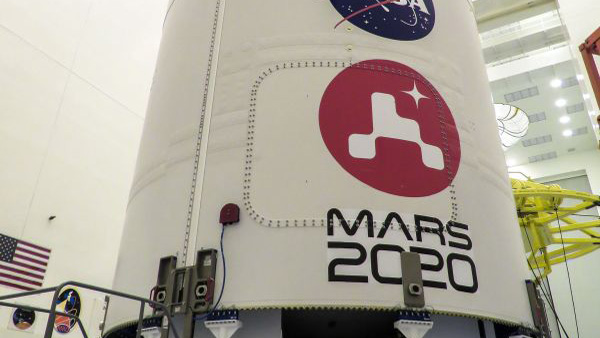NASA's Mars rover Perseverance is ready for its July 30 launch

NASA's next Mars rover just cleared a big hurdle on the path toward its planned launch next week.
The $2.7 billion Mars 2020 Perseverance rover mission passed its flight readiness review (FRR) Wednesday (July 22), keeping the mission on track to lift off from Florida's Cape Canaveral Air Force Station on July 30, NASA officials announced.
The FRR "was an opportunity for the Mars 2020 team and launch vehicle provider United Launch Alliance to report on the readiness of the spacecraft, along with the Atlas V rocket, flight and ground hardware, software, personnel and procedures," agency officials wrote in an update on Wednesday.
Related: NASA's Mars 2020 Perseverance rover mission in photos
Everything checked out, so the mission and launch teams now have just one more big milestone to check off before liftoff: the launch readiness review, which is scheduled to take place on July 27.
"At present, everything is green across the board," Matt Wallace, Mars 2020 deputy project manager at NASA's Jet Propulsion Laboratory (JPL) in Pasadena, California, said in Wednesday's update. "Everyone involved with this endeavor, from the spacecraft team to the launch vehicle team to those working the range, are looking forward to seeing Perseverance begin its long-awaited flight to Mars."
Mars 2020's launch window extends from July 30 through Aug. 15. Whenever Perseverance lifts off, it will land on Feb. 18, 2021, inside the 28-mile-wide (45 kilometers) Jezero Crater, which harbored a lake and river delta in the ancient past.
Breaking space news, the latest updates on rocket launches, skywatching events and more!
Perseverance will hunt for signs of long-dead life, characterize Jezero's geology in detail and perform a number of other tasks. For example, the rover will collect and cache several dozen samples, which a joint NASA-European Space Agency campaign will bring back to Earth, perhaps as early as 2031.
Perseverance won't make the long journey to Mars alone. A 4-lb. (1.8 kilograms) helicopter named Ingenuity is attached to the rover's belly and will deploy in a suitable spot early in the mission. Ingenuity will then make a handful of test flights in the Martian sky, becoming the first rotorcraft ever to operate on a world beyond Earth.
Launch windows for Mars missions come around just once every 26 months. Several other missions are taking advantage of the current opportunity: the United Arab Emirates' Hope orbiter launched on July 19, and China's Tianwen-1 mission, which features an orbiter, lander and rover, is scheduled to lift off tonight.
A fourth mission, the European-Russian ExoMars rover, was supposed to leave Earth this summer as well. But it encountered technical problems and now must wait until 2022 to get off the ground.
Mike Wall is the author of "Out There" (Grand Central Publishing, 2018; illustrated by Karl Tate), a book about the search for alien life. Follow him on Twitter @michaeldwall. Follow us on Twitter @Spacedotcom or Facebook.

Michael Wall is a Senior Space Writer with Space.com and joined the team in 2010. He primarily covers exoplanets, spaceflight and military space, but has been known to dabble in the space art beat. His book about the search for alien life, "Out There," was published on Nov. 13, 2018. Before becoming a science writer, Michael worked as a herpetologist and wildlife biologist. He has a Ph.D. in evolutionary biology from the University of Sydney, Australia, a bachelor's degree from the University of Arizona, and a graduate certificate in science writing from the University of California, Santa Cruz. To find out what his latest project is, you can follow Michael on Twitter.
